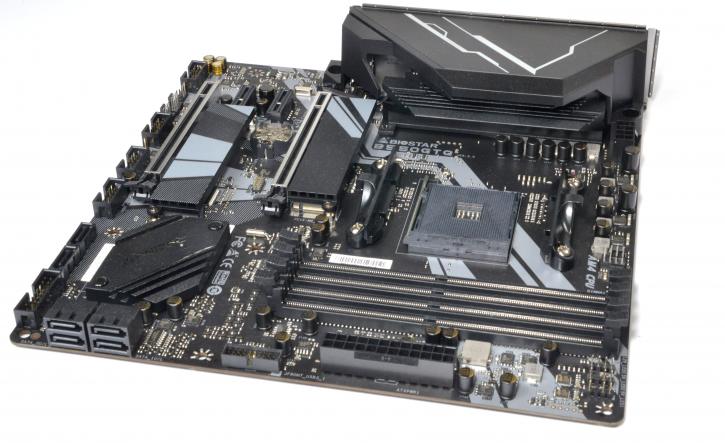Final Words & Conclusion
Conclusion
The Biostar B550 GTQ clearly is just an ‘ok’ addition to the market. Still, there are not so many mATX B550 boards out there, so it certainly can find its niche. For RGB lovers, there are two addressable and one regular LED strip header. The DDR4 slots support up to 128 GB of memory. This motherboard also handles up to DDR4-4933 memory, which is impressive (but we haven’t checked if it actually works). The Biostar B550 GTQ has only a single main PCIe 4.0 x16 slot supported by the processor, and there is a PCIe 3.0 x4 slot accompanied by two PCI 3.0 x1 slots. The audio on this board looks very outdated (like from 5 years ago), with the Realtek ALC1150 codec. The M.2 slots support one PCIe 4.0 x4 drive and one PCIe 3.0 x4 drive. Overall, the B550 really is an optimal chipset for the Ryzen processor for most users. The price of the Biostar B550 GTQ is about 130 USD, which makes it a rather cheap proposal. The board also has quite acceptable 6+4 power delivery.
DDR4 Memory
Memory compatibility should not, and likely will not be an issue as long as you stick to recently released DIMMs. I'll keep repeating this, but there are some really good Ryzen-optimized kits out there. With Ryzen Generation 3 you can go higher in DDR4 clock frequency if you want to. We’d say that up to 3600 MHz CL16 is fine. If you go beyond this value, a 2:1 divider kicks in (but you can achieve even 3733 or 3800 MHz with a bit of effort and/or luck). This, in turn, may affect Infinity Fabric bandwidth and inter-core CCX bandwidth. We see no reason for faster DDR4 memory anyways. It's expensive and does not bring in added perf, as you can see in our Ryzen RAM gaming test. It’s better to have 4 banks occupied with double-sided memory.
Power consumption
With Ryzen 3000 processors now fabbed in 7nm, you may see some interesting energy efficiency. We used an 8-core 3700X with this B550, which is really adequate. The load values are nice, but not perfect.
Performance & tweaking
This motherboard will not be a restriction for tweaking and overclocking. Processor and ASIC quality, alongside cooling, are the more important factors these days. The original Ryzen products from 2017 offered clocks in the 3900~4000 MHz range on all cores. Then, Ryzen 2000 / Zen+ brought it up a notch. Finally, Ryzen 3000 seems to handle an all-core clock of 4300~4400 MHz at best. Our Ryzen 7 3700X was able to reach a stable 4400 MHz, but that was done with proper liquid cooling, and it’s really the absolute maximum. If you tweak to the limit, likely 1.425V~1.450V is needed for a stable 4.3 GHz on all cores. The thing is, and I have been thinking about this for a long time, I would not recommend overclocking and tweaking at all. These processors can boost 1 or 2 cores to 4500 or 4600 (even 4.7 GHz for the 16-core model). So, while the rest of the cores will be binned slower, that's where you get your extra gaming performance. The positives of an all-core 4400 Mhz overclock would not outweigh the positives of the default high Turbo clocks. It is something to think about for sure. At the very least, you can try and see what works best for you. However, the binned clock recipe that AMD has applied to these processors by default will likely work best in most aspects, and this includes power consumption as well. This is going to be a generic and general consensus for all multi-core processors really.
Final words
With the B550 chipset, you get a single PCIe 4.0 for graphics, one M.2 slot, and overclocking ability. This should be enough for the majority of consumers. X570 is not worth the price premium for this user base. We also need to emphasize that B450 motherboards were significantly cheaper but, on the other hand, most B550 products are really fine, including in the VRM department. The Biostar B550 GTQ should handle even the 12-core Ryzen 9 3900X (we wouldn’t recommend the 16-core 3950X here due to the VRM). The price is about 130 USD, so it’s affordable for a B-series chipset. But there is no such thing as a free lunch, so there’s only one 1 Gbps LAN, a total of 4 fan headers, and only the ALC1150 audio codec (what year is it? 2015?). On the other hand, it’s one of the few mATX options out there, so there should still be some demand for that type of mobo. We can’t recommend this board mainly due to very mediocre VRM, old audio codec, and a very sparse amount of fan headers (for the majority of users it should be ok, but still). There’s really nothing there (except the form factor) that makes it stand out from the crowd.
Handy related downloads:
- Sign up to receive a notification when we publish a new article
- Or go back to Guru3D's front page


